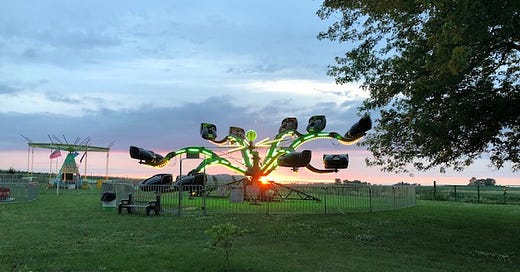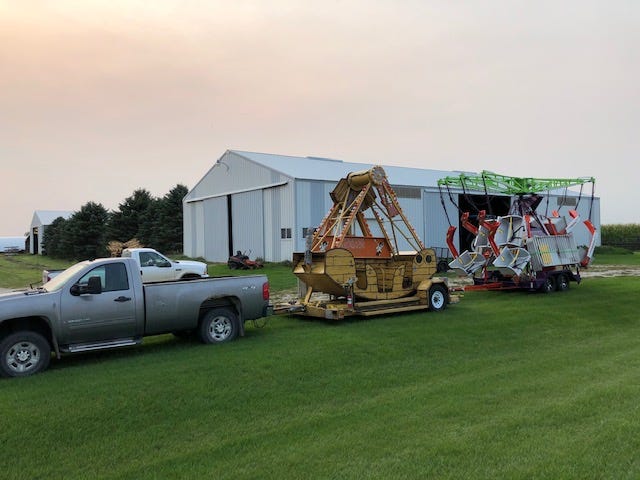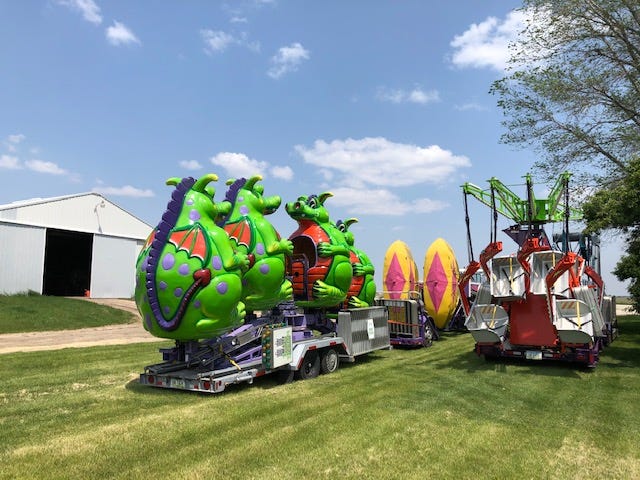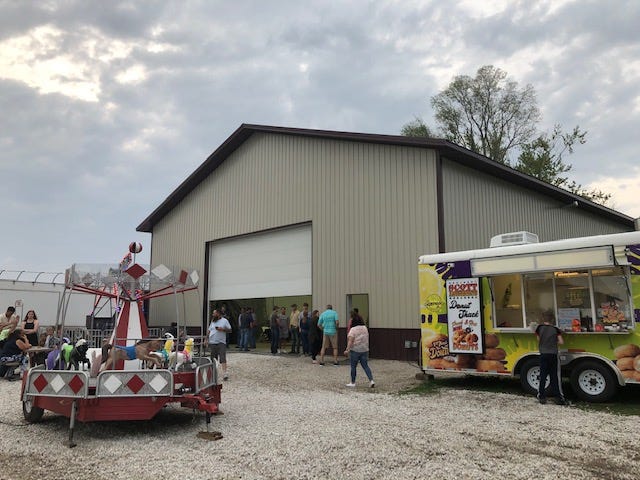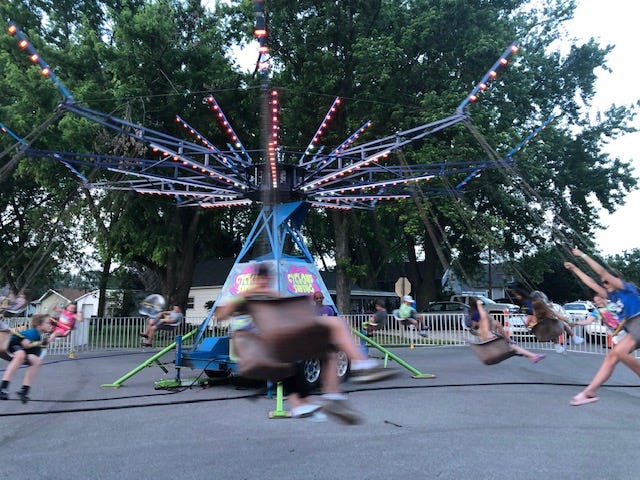Americans today spend 6,259 hours annually mesmerized by their screens: phones, laptops, and TVs. They enter virtual worlds, seek out virtual experiences, and create alternate personas.
But who needs the Meta Universe or an Avatar, when you can escape your workaday world, or ignore societal expectations for an evening filled with the unique sights, bright lights, and tantalizing aromas of the Midway carnival?
Five generations of Americans have been standing in line to enter the make-believe portal of the Midway world, seeking novel experiences . . . defined boundaries of risk . . . and a world where the imaginary meets the real.
The roots of the modern traveling carnival go back to the Midway Plaisance at the 1893 Chicago World's Fair. An astounding 2,160 people boarded the first steel Ferris wheel there -- six cars carrying 60 passengers each -- for a 264-ft. bird’s eye view of the Fair and the city of Chicago.
My grandmother traveled there from Iowa by train with her parents, and her handwritten journal shares the excitement of seeing Buffalo Bill's Wild West Show, along with Annie Oakley, near the Midway Plaisance.
In 1902, long before automobiles lured rural Americans away to big city entertainment, the U.S. had an estimated 17 traveling carnivals. By 1937, the number had catapulted to 300.
After World War II, carnivals gradually began to decline. But, even in the early 1960s, the arrival of the carnival in my small Iowa town generated excitement for farm kids like me. Arnold's Park at Lake Okoboji and other resort towns already offered amusement parks, but
It would be a decade before the advent of permanent amusement or theme parks in the Midwest.
Today's carnivals typically only travel within a circuit of county and state fairs, and community festivals. Yet summer evenings wouldn't be the same without this enduring tradition that allows everyone, regardless of age, to step onto a ride, and become a kid again. But, after leaving this magical world where things aren't always what they seem, do you ever wonder: Where do carnivals come from? Where do they go after the summer season?
It's A Merry-Go-Round
You're in luck! I don't have a general admission badge, but I can offer one ticket admitting you to a behind-the-scenes glimpse of a carnival that sprouted in a west central Iowa cornfield.
My husband and I descend from a long tradition of farm families. So how did my husband find himself hauling two mini-merry-go-rounds from Denison to Webster City last week?
You might say it began with the marriage of my husband's sister, Lorna, to Rob Scott 26 years ago. But Rob also has seen photos of his grandpa's small carnival in Des Moines, and his dad told stories of setting up and operating its small carousel. When his dad married a farm girl from Palmer, he left the carnival life behind.
Fast forward three decades, when Rob and his brother Russ were teenagers looking for summer jobs, and they were hired by a family acquaintance. The owner, Steve Smith, had graduated from Stratford High School in 1971 and purchased his first hotdog stand in the same year. That launched his career in the amusement and concessions industry, including the Iowa State Fair, while continuing to farm.
In 1987, Steve and his wife Vicki started Smith Kidland, which grew into Smith Amusements in 1991. The Scott brothers worked summers for them throughout high school, and remained close to the Smith family. When the Smiths retired, the Scotts had gained work experience in food service, catering, and operating farm equipment. The two brothers seemed like good candidates to carry on the tradition. Rob, who received a diagnosis of multiple myeloma in 2016 at age 46, had reached a fork in the road. "I already had lived longer than I was expected--I wanted to work at a business of my own the rest of my life," he says.
After convincing a rural, farm bank of the loan-worthiness of a carnival business, Scott Amusements began buying rides on contract in 2019. Covid-19 lockdowns in 2020 slammed them hard in their first season. But Covid didn't stop people from loving fair food, right? We're talking cotton candy, ice cream, fried doughnuts, funnel cakes, corndogs and more! Scott Amusements held a drive-through fair concession event at their farmstead in April, 2020. Word-of-mouth and Facebook promoted the event, and cars lined up for a quarter mile along their two-lane blacktop road.
"There were 600 shares of the original post," Lorna recalls "We had planned for four days, based on specific set hours of business, figuring 20 cars per hour. The food was all gone in five hours. We had to scramble and drive miles to get enough to meet the demand."
More drive-throughs followed. It didn't replace their projected 2020 carnival income, but it helped keep them in business. Carnival spending rebounded in 2021, thanks to a boost from Pandemic stimulus funds.
Forming a Family of Choice
Today, the carnival has grown to two units, with 18 rides and seven food stands. Their oldest son is part of the business. My sister-in-law helps with finances, and ticket sales, and all the couple's seven children have worked there at one time or another. Rob's youngest brother and his wife, and their oldest daughter help on weekends when the carnival's in central Iowa. Another adult niece and nephew come to work during the summers.
Each unit has 20 employees. But they might hire as many as 100 employees throughout the summer because many employees work around their other jobs, and college kids return to school in early August. This year, they hired two countertop installers whose jobs slowed down this summer; they don't speak English.
"Rob has a soft heart for his employees," Lorna says. "Some have had a hell of a life." Occasionally, new hires don't work out. And, yes, conflict management is required. But it can be rewarding.
Two current employees were driving through Des Moines, headed to California from Philadelphia, when they saw an ad for the carnival. They lived in a nearby town last winter while he worked on equipment in the shop. Last year was her first time at the Iowa State Fair, and her curiosity about livestock, crops, and farming is endless. "She loves this little town because she can walk her dog at night without fear," Lorna says. "She walks to the post office in peace and quiet, without sirens. She says it's the nicest place she's ever lived."
Lorna recalls a 20-year who was allowed to work, on the condition that Rob checked in with the boy's parole officer weekly. "He was a good kid in a terrible situation," Lorna says. Today he's a supervisor at a cabinet-maker business in eastern Iowa. "He still calls me 'Mom' when we hear from him," Lorna says.
(Small wonder that Lorna and Rob adopted six of their seven children from foster care 15 years ago. All had graduation parties at the farm, but the three youngest were able to offer the unique fun of carnival rides there.
There's Always Next Year
Carnivals convey a carefree lifestyle. But you need to have a shrewd sense of business to make a profit.
Now that I think of it. Growing a carnival in a cornfield isn't that different from farming. It's a capital-intensive business, with hard work, all kinds of weather impacting your profits, mechanical problems, juggling work and family relationships, labor issues, and an intensive summer season.
Lorna does miss raising crops and livestock. "But I've always said that the carnival business is a lot like farming," she says. "You can't guarantee how much you'll take in, with all of the unpredictables. Hydraulics repair is a big expense for both."
"People don't see the long hours, the set-up, the tear-down, the labor, the impact of weather," Rob agrees. They don't think of the trek to the courthouse in October to register vehicles, rides, equipment, and trucks or the inspections to ensure safety. The fuel tab for a carnival date could easily amount to $30,000 to $40,000. Then there's the cost of swag.
So, what's the appeal to a carnival owner who knows what it takes to produce this traveling illusion? Come out at dusk on a warm summer night, with a gentle breeze wafting a smorgasbord of aromas. Take in the display of mesmerizing, multi-colored lights reflecting from the spinning rides, and watch the young couples holding hands as they step onto the Ferris wheel. Listen to the sounds of the children's laughter, and their shrieks of excitement. Watch their faces.
"The other day in Eagle Grove, lots of Hispanic families came to the carnival -- and they just loved us," Rob recalls. "When we left town, the kids stood in their yards, and waved goodbye. One shouted, 'See you next year'. It's all for the kids -- and the smiles!"
I’m delighted to be part of the IOWA WRITERS’ COLLABORATIVE
